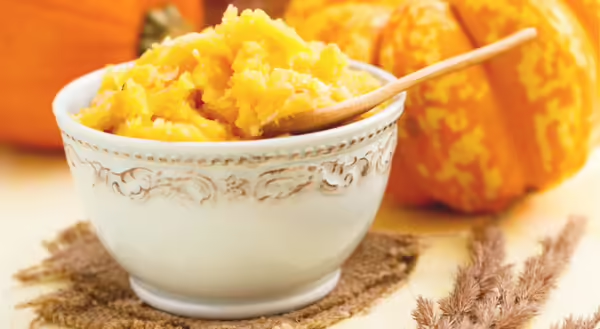
Like many winter squash, pumpkins are packed with essential nutrients to fuel your body and keep it healthy. Pumpkins are one of the falls great superfoods because they contain so many disease-preventing nutrients.
Pumpkins are a rich source of vitamins A, B1, B6, and C. They also contain calcium, copper, folate, manganese, and potassium, making them a great heart-healthy food choice. There are many other health benefits from consuming pumpkins as part of a healthy diet. This is partly due to the nutrients in pumpkins that can boost your immune system, protect your vision, and reduce your risk of certain cancers.
This versatile fruit, yes, pumpkins technically speaking are fruit, can be used in both savory and sweet recipes. Although pumpkins are nutrient-dense, generally low in calories, and a good source of fiber, they are often added to high-sugar and fat ingredients. Therefore, to help you on your wellness journey, I will talk about making fresh pumpkin puree.
Make A Pumpkin Puree
Making fresh pumpkin puree to add to any delicious pumpkin dish can be very rewarding! Plus, it will not have any added preservatives. Pumpkin puree is simply cooked blended or mashed pumpkin. And there are several ways to make pumpkin puree. You can use the oven, microwave, or even the stovetop.
Selecting Your Pumpkin
Before we can begin making our pumpkin puree, there are a few things we need to talk about. There are two general categories of pumpkins, baking or processing pumpkins, and ornamental or decorative pumpkins. The best pumpkins for baking and cooking are called processing pumpkins and may also be called “pie” or “sweet” pumpkins.
These pumpkins are ideal for baking because they are sweeter, more flavorful, less watery, and have a less grainy texture than ornamental pumpkins. Generally, these pumpkins are smaller in size and have smooth-textured flesh, so they are easy to pick out.
When selecting baking pumpkins, choose a small pumpkin, ideally between 4-8 pounds. If you do not have a scale handy, simply select a pumpkin that seems heavy for its size; this will indicate a great pumpkin! Make sure your pumpkin is firm, unblemished pumpkins, and free of soft spots, nicks, cuts, or cracks. Also, ensure your pumpkin has a stem, especially if you are not planning to bake it right away.
Can You Bake with Ornamental Pumpkins?
Yes, you can. However, the qualities that make them good decorative pumpkins will not necessarily make them good baking pumpkins. The characteristics desirable for a pumpkin intended to be an adorable jack-o-lantern that will withstand the wear and tear of being sculped and displayed are not the same as those of a baking pumpkin. If you use an ornamental pumpkin, just know it will not be as flavorful as a pie pumpkin, and it will be watery and often has a very stringy texture.
3 Methods to Make Pumpkin Puree
Baking Method
- Wash hands with warm water and soap. Preheat the oven to 375 °F.
- Wash and cut a fresh baking pumpkin in half and discard the strings and seeds.
- In a shallow baking dish, place the two halves face down and cover with baking foil.
- Bake pumpkin at 375 °F for 1 ½ hours, or until tender.
- Remove the pumpkin from the oven and allow it to cool.
- After cooling, scoop out the flesh of the pumpkin and mash it into a puree. You can do this by hand, with a mixer or food processor.
- For a silkier texture, press the pumpkin puree through a sieve.
Microwave Method
- Wash hands with warm water and soap.
- Wash and cut a fresh baking pumpkin in half and discard the strings and seeds.
- In a shallow microwave-safe baking dish, place the two halves face down. Cover tightly with a microwave-safe wrap to prevent steam and moisture from escaping during cooking time.
- Microwave on high power for seven minutes per pound of pumpkin. Repeat this process until the pumpkin is tender.
- CAUTION: When removing plastic wrap, pull the wrap furthest from you back towards you, allowing hot steam to escape away from you.
- Wash your hands and peel the skin from the cooled pumpkin using your fingers.
- Puree peeled pumpkin using a hand masher, mixer, potato ricer, or a food processor.
Stovetop Method
- Wash hands with warm water and soap.
- Wash and cut a fresh baking pumpkin in half and discard the strings and seeds.
- Cut pumpkin into uniform 1-inch cubes.
- Place pumpkin in a large saucepan or stockpot and cover with water.
- Bring pumpkin to a boil and reduce the heat to low, and simmer for 25-30 minutes, or until tender. Stir pumpkins occasionally to prevent scorching.
- Remove pumpkins from heat, drain, and allow to cool.
- Wash hands and remove the skin from the pumpkins, it should skip right off.
- Puree pumpkin using a hand masher, mixer, potato ricer, or food processor.
Storing Your Fresh Pumpkin Puree
Fresh pumpkin puree can be refrigerated for up to three days or stored in the freezer for up to six months.
Whether you make fresh pumpkin puree or purchase it at the grocery store, pumpkin is a delicious and healthy addition to your fall food lineup. If you buy pumpkin puree from the grocery store, pay close attention and ensure you are getting 100% pumpkin puree with no added salt or sugar.
References
Brennan, D. (2020, September 18). Pumpkin: Health benefits, nutrients per serving, and more. WebMD. Retrieved October 13, 2022, from https://www.webmd.com/diet/health-benefits-pumpkin#:~:text=It%20offers%20a%20long%20list,and%20your%20blood%20pressure%20low.